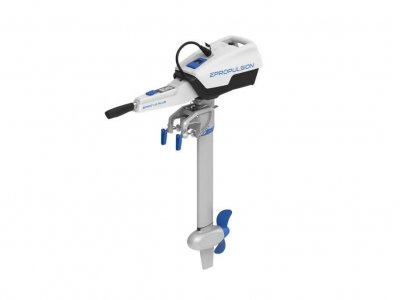Reviews • News • Tips & Articles • New Boat Library • Trades & Services • Boat Shows • Boating Terms
Electric Outboard Motors: All You Need To Know

For the purposes of this review we will investigate small (approximately 3hp) outboards. We are all familiar with 2 stroke outboards (dirty but light, no longer manufactured) and 4 stroke outboards (cleaner but relatively heavy). So how does the new range of eco-friendly electric outboards compare.
Useability
Electric outboards are fun and easy to use. No more arm wresting the starter and hitting your partner with the over enthusiastic starting pull. Press the power button and you are good to go. Acceleration is smooth and instant and everyone wants to have a go. People who normally do not want to drive dinghies seem to enjoy the quiet ease of electric outboards.
Having a battery that easily disconnects from the drive unit breaks the weight in half for transporting and removing the outboard from the transom also improving useability (11 kg motor plus 9 kg battery).
Zero maintenance is a huge bonus along with being totally clean. No oil leaks or exhaust soot to dirty the car or bunk. So for useability an electric outboard wins hands down over petrol outboards.
Eco-Friendliness
At first glance the electric outboard would seem to be far more eco-friendly and it probably is. Zero emissions vs the underwater exhaust gases of petrol outboards are a clear benefit for electric outboards especially in nature reserves or other eco sensitive environments. The equation only changes if we use generators to recharge our batteries. If your solar panels charge your house batteries which then (via an inverter) charge your outboard battery then all good. However, if we are recharging from our 10kw diesel generator then the equation changes. Still, we may need to run our generator anyway (watermaker, refrigeration, general charging) and so the additional load from charging the outboard battery is then irrelevant. So electric outboards are definitely more eco-friendly than a petrol outboard – only the amount is variable depending on charging method.
Energy Density (Range)
The biggest difference between petrol and electric outboards is the energy density of the fuel source which determines range. Current lithium-ion batteries have approximately 10% of the energy density of petrol. So a 10kg lithium battery has the approximate energy equivalent (read range) of 1 litre of petrol. No problem if you can recharge regularly and the primary use is ship to (close) shore but for longer journeys petrol still has the advantage.
Which Electric Outboard
We chose the E-Propulsion Spirit 1.0 Plus and are very happy with its performance. It performs in line with advertised specs and has been trouble free. Our top speed in a 3.1m aluminium RIB is 4.3 knots which gives us 55 minutes of runtime for a range of 4 nautical miles. If you throttle back to 3 knots the runtime goes up to 3 hrs giving a range of 9 nautical miles. The high thrust propellor is almost as comfortable in calm conditions as in 30 knots of headwind. A useful comparison of electric outboards as at September 2023 can be found at https://www.youtube.com/watch?v=1Ac3-yPOF9k



